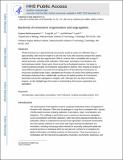Bacterial Chromosome Organization and Segregation
Author(s)
Badrinarayanan, Anjana; Le, Tung; Laub, Michael T
Downloadnihms749011.pdf (1.193Mb)
OPEN_ACCESS_POLICY
Open Access Policy
Creative Commons Attribution-Noncommercial-Share Alike
Terms of use
Metadata
Show full item recordAbstract
If fully stretched out, a typical bacterial chromosome would be nearly 1 mm long, approximately 1,000 times the length of a cell. Not only must cells massively compact their genetic material, but they must also organize their DNA in a manner that is compatible with a range of cellular processes, including DNA replication, DNA repair, homologous recombination, and horizontal gene transfer. Recent work, driven in part by technological advances, has begun to reveal the general principles of chromosome organization in bacteria. Here, drawing on studies of many different organisms, we review the emerging picture of how bacterial chromosomes are structured at multiple length scales, highlighting the functions of various DNA-binding proteins and the impact of physical forces. Additionally, we discuss the spatial dynamics of chromosomes, particularly during their segregation to daughter cells. Although there has been tremendous progress, we also highlight gaps that remain in understanding chromosome organization and segregation.
Date issued
2015-11Department
Massachusetts Institute of Technology. Department of BiologyJournal
Annual Review of Cell and Developmental Biology
Publisher
Annual Reviews
Citation
Badrinarayanan, Anjana et al. “Bacterial Chromosome Organization and Segregation.” Annual Review of Cell and Developmental Biology 31, 1 (November 2015): 171–199 © 2015 by Annual Reviews
Version: Author's final manuscript
ISSN
1081-0706
1530-8995